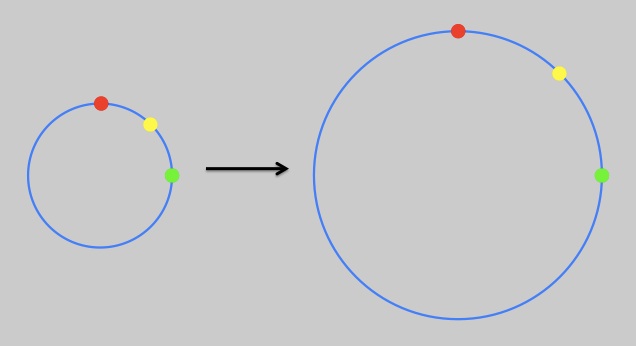Physicist: You’ll often hear that “the universe is expanding faster than the speed of light”. However, this statement is akin to statements like “green is bigger than happy”. It’s not even wrong.
There are two big things to remember about the expansion of the universe. First, the universe doesn’t expand at a particular speed, it expands at a speed per distance. Right now it’s about 70 kilometers per second per megaparsec. That means that galaxies that are about 1 megaparsec (1 parsec = 3 lightyears and change) away are presently getting farther away at the rate of 70 km every second, on average. Galaxies that are 2 megaparsecs away are presently getting father away at the rate of 140 km every second, on average.
Notice the awkward phrasing there: distant galaxies are “getting farther away”, but oddly enough they are not “moving away”.

Initially, the distance between Red and Yellow is 1, and the distance between Red and Green is 2. After doubling the size of the “universe” the distances are 2 and 4, respectively. Yellow receded by 1, but Green receded by 2. Green would seem to be “moving” faster than Yellow, but in fact all of the dots are sitting still while the space they inhabit expands.
The easiest way to think about the expansion of the universe is to think about the expansion of something simpler, like a balloon. If for some reason you have a balloon covered in ants, and you inflate it slowly, then the ants that are nose-to-nose (pardon, “antennae-to-antennae”) with each other will barely notice the expansion. However, the farther two ants are apart, the more the expansion increases the distance between them. If an ant on one side tries to run to one of her sisters on the far side of the balloon, she may find that the distance between the two of them is increasing faster than she can close that distance.
The distance at which this happens (where the rate at which the distance decreases because of the movement of the ant and the rate at which the distance increases due to the expansion of the balloon) is a kind of “ant horizon”. Any pair of ants that are already farther apart than this distance can never meet, and any pair closer than this distance may (if they want). In the picture above, if an ant can run a distance of 2 during the expansion time, then an ant starting at the yellow point could reach the red point, but an ant starting at the green point will always find itself maintaining the same distance from the red point.
The “ant horizon” is a decent enough analog for the edge of the visible universe. The speed at which the ant runs is described with respect to the part of the balloon it’s presently standing on and the speed at which light travels is with respect to the space it travels through (technically with respect to objects that are “sitting still” in space). The oldest photons we see are those that have come from just barely on the near side of the distance at which light can’t close the gap. It’s not that things beyond that distance are moving away faster than light (almost all the galaxies and gas and whatnot are moving slowly with respect to “the balloon”), it’s that the light they emit just isn’t moving fast enough to overcome the expansion. Light beyond that is still moving at light speed, and it may even be trying to move toward us, but the distance is simply expanding too fast.
Here the analogy breaks down and starts making our intuition incorrect. When you inflate a balloon the sides are obviously moving apart. You can use a rule (maybe a tape measure) and a stopwatch and you can say “dudes and dudettes of the physics world, the speed of expansion is ____”. Even worse, when a balloon expands it expands into the space around it, which begs the question “what is the universe expanding into?“. But keep in mind, all that physics really talks about is the relationship between things inside of the universe (on the surface of the balloon). If you draw a picture on the surface of a balloon, then if the balloon is dented somewhere or even turned inside-out, the picture remains the same (all the distances, angles, densities, etc. remain the same).
Point of fact: it may be that the balloon is a completely false metaphor for the universe as a whole, since the best modern measurements indicate that the universe is flat. That is, rather than being a closed sphere (hypersphere) it just goes forever in every direction. This means that there is genuinely no way to describe the expansion of the universe in terms of a speed (there’s no “far side of the balloon” to reference).







Pingback: Why Space Is Dark – Storm news